A Budget Home Theater & PC Setup: 4K, HDR, UHD Blu-ray, and More
by Ganesh T S on December 26, 2017 8:30 AM ESTLocal Media Playback
Our typical HTPC testing flow involves playing back files encompassing a range of relevant codecs, containers, resolutions, and frame rates. A note of the efficiency is also made by tracking GPU usage and power consumption of the system at the wall. Over the last year or two, the focus has been on using Kodi and MPC-HC with its built-in LAV filters for benchmarking. Even though we have had non-HDR 4K clips for some time now in our test suite, we have not subject them playback at native resolution. In order to augment our test suite, we have added two files, a 4Kp25 HEVC HDR stream in a MKV container, and a 4Kp60 VP9 Profile 2 HDR stream in a WebM container.
Out of all the options we evaluated, the TCL 55P607's in-built Roku platform is the only one capable of handling Dolby Vision videos. However, when we tried to play back a sample file, the Roku interface stalled in the retrieving stage after the appearance of the Dolby Vision logo.
The TCL 55P607 Roku Media Player App - Unable to Handle Local Dolby Vision Files
Due to the absence of reliable open-source editing and decoding tools for Dolby Vision in the PC space, its testing with local media files will have to wait.
The Roku Media Player app continues to be a disappointment for users with anything other than the standard H.264 / HEVC-based camcorder files. The following recorded clip shows its failure with some interlaced MPEG-2 and H.264 clips in TS containers. VC-1 is also not supported.
On the plus side, we have automatic switching to HDR for local files which have HEVC HDR content. On the othr hand, a VP9 Profile 2 HDR clip did not generate the mode switch.
We tracked the power consumption of the TV while the Roku interface tried playing back the various files in our test suite. It was not much of a surprise to find that Roku fails to play back many of the streams. The graph segments below corresponding to the files that didn't play back are just the display remaining idle in the Roku USB Player interface.
The NVIDIA SATV supports all files in our test suite except the one encoded in VP9 Profile 2. With Kodi, we even see the HEVC HDR file being decoded and sent to the display with the appropriate mode switch.
The NVIDIA SHIELD Android TV Supports HDR Playback with Local Files
The power consumption of the SATV was tracked during the playback of each file in our test suite using Kodi 17.6. The segment corresponding to the VP9 Profile 2 file is just the duration for which the audio track was decoded and the Kodi UI remained idle.
Moving on to the PC space, we first compare the DXVAChecker outputs for the three systems. The Zotac EN1080K with its GTX 1080 GPU does not support hardware decoding of VP9 Profile 2 videos. Even if a HDR stream were to be available, the system plays back only the non-HDR versions with the desktop in HDR mode.
The Absence of VP9 10-bit Profile 2 Decoding in the GTX 1080 is the Only Odd Spot (from L to R: ASRock Beebox-S 7200U, Zotac ZBOX MAGNUS EN1080K, and the Intel NUC7i7BNHX1)
We found the native Microsoft Movies & TV app to be capable of playing back HDR videos with the desktop in HDR mode. A comparison of playback using two different players in that mode is shown below.
However, the playback of HDR files in non-HDR mode using the Microsoft Movies & TV App results in messed up colors. As such, we don't recommend the Movies & TV app for HDR file playback under all circumstances.
It is possible to use the madVR renderer in conjunction with a suitable player to shift the display to HDR mode independent of the OS setting. It is also supposed to bring the display back to the original state when exiting. We tested it out with MPC-HC and madVR v0.92.10 on the Zotac EN1080K. On the KBL-U systems, using madVR as the renderer resulted in evident dropped frames irrespective of the setting. On the Zotac EN1080K, we found that the latest NVIDIA driver release (which we absolutely had to use for Netflix 4K playback) seemed to have some issues with the restoration of the previous mode. With certain settings, the colors seemed to get crushed significantly after madVR triggered the mode change.
In fact, the only reliable combination in which we could get playback of the files in the appropriate mode was to set the OS toggle for HDR, and allow madVR to pass through the HDR metadata directly to the display (something that the madVR author specifically mentions as unsuitable for purists). We do not have automatic mode switching or even identification of HDR when using Kodi (as of v17.6). With madVR and MPC-HC, it is possible, but the consumer experience may vary.
In our opinion, HDR local media playback is yet to reach a stable state with commonly used software combinations. CyberLink's PowerDVD 17 also supports automatic HDR mode switch for playback of local files on Intel GPU-based systems. We found that it worked well in both of the KBL-U PCs, but, PowerDVD unfortunately refused to play back the VP9 Profile 2 files on those systems.
The power consumption of the three PCs during the playback of each file in our test suite using Kodi 17.6 was recorded. The same was done using the Microsoft Movies & TV app also, but, we found significant power consumption change (up to 10W at the wall) when the control overlay appeared on the screen. As such, we believe that the Microsoft Movies & TV app is not a reliable way to determine media processing efficiency of any system.
A similar graph for the madVR playback case in the Zotac ZBOX EN1080K (with OS HDR toggle set and madVR configured for HDR passthrough in full screen windowed mode) is presented below.
The power consumption numbers were also graphed for the PowerDVD playback case using the two KBL-U systems.
In general, we find that the Zotac system consumes a lot of power, but, it also performs a lot better compared to the KBL-U systems when advanced HTPC requirements like madVR rendering are considered. The HDR ecosystem is just getting started and we are waiting for things to reach a more matured state before doing a detailed analysis of the playback of local HDR files in PCs.


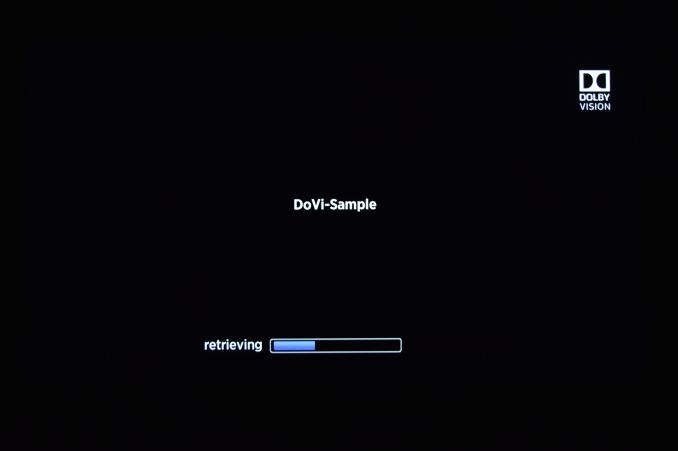

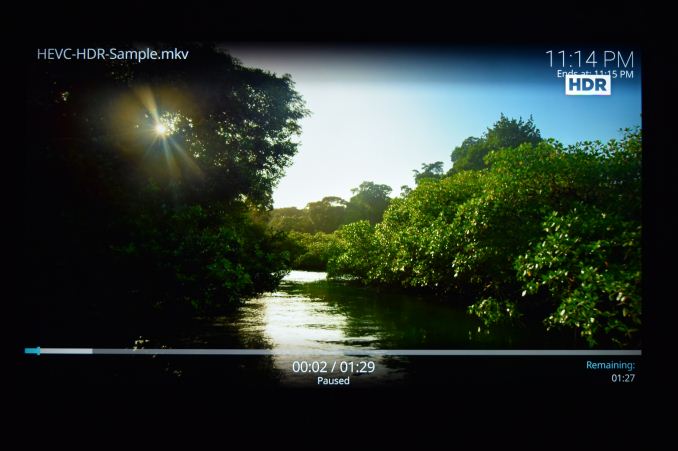
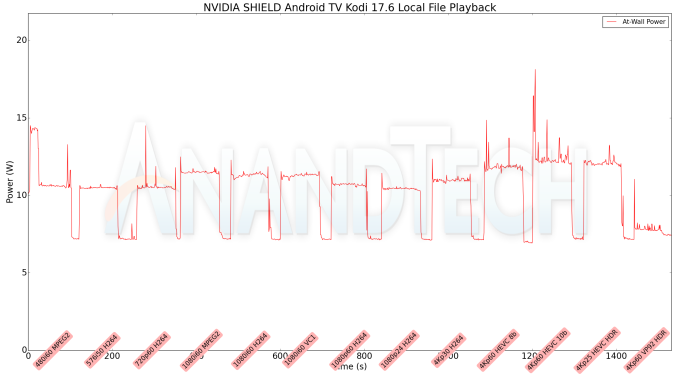
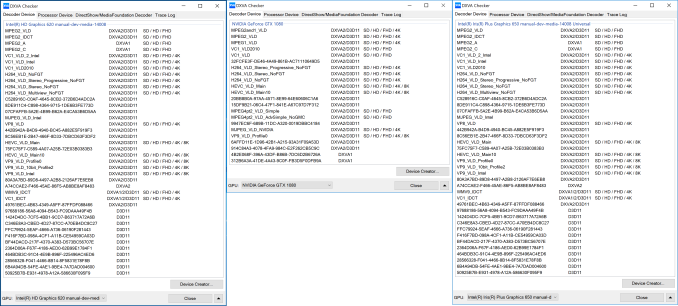
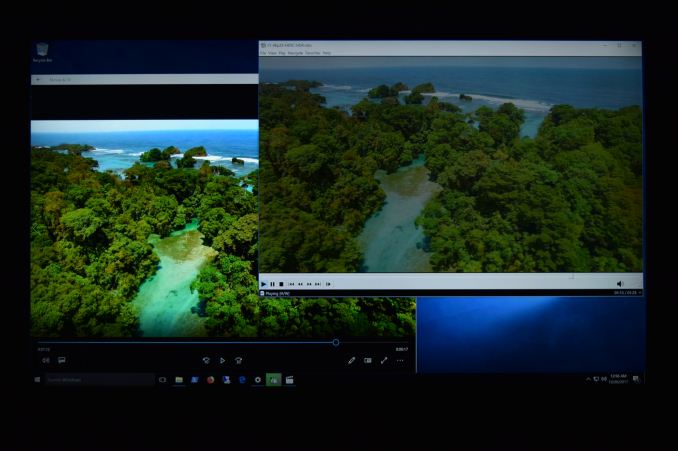
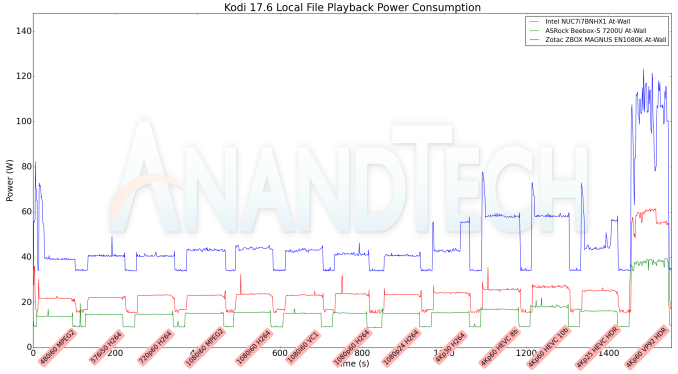










191 Comments
View All Comments
mikato - Thursday, January 18, 2018 - link
Great point, and I also agree... unless you want local storage for media content. Sure I guess the response would be to have a PC (when we had been leaving out the PC) or a NAS feed content with DLNA or whatever that is with Plex or Kodi over the network. But then you have quite a bit more than just whatever box or stick. And if you wanted to bring your content with you to a friend’s house, you couldn’t do that, when you might be able to pretty easily with one of the UCFF PCs with a disk in it. Plus I’ll add that would be able to play anything, when for instance you might not be able to play YouTube with your Amazon stick or play Amazon with your Google stick.We’re close, but not quite there yet. What is there does cover things enough for a lot of people though.
Duto - Friday, December 29, 2017 - link
A TCL TV set?, really? , unbelievable!rapster - Friday, December 29, 2017 - link
Thank you for your thoughtful review of some of the tricks, traps, and solutions of the 4K HDR space. As someone who recently had to deal with a few of the challenges you worked through I really appreciate it. Your recommendation of the NVIDIA Shield is especially well-considered and would have saved me a lot of time for my applications. The comments section here has some gold to be mined as well.As for budget: I paid twice as much for my receiver as the $999 one you recommended and still consider it to be a budget unit. Anybody who has been to a "real" media equipment store understands this. Sorry to be "that guy" on my first post here, but I might suggest it's time for some folks (cough ddriver) to leave mom's basement and that job at the mall and get out more.
ronraxxx - Friday, December 29, 2017 - link
THANK YOU - I was getting so triggered reading these comments. "Budget" is relative. A brand new Kia costs $10,000 - it's still a *budget* vehicle in the world of new cars. Real home theater equipment is expensive - the key word being "THEATER." If you want a true, immersive, theater-like experience it usually is very expensive. If you only have $1000 to spend on your home "theater" I hate to break it to you but the TV, soundbar, and Roku that fits your budget isn't really a theater at all, unless you're in a dorm room.Reflex - Friday, December 29, 2017 - link
This right here. People get hung up on the word Budget. If the author could do one thing differently IMO it would be to define what the actual price tiers he is using are. People could yell all they wanted about how a $500-2000 range for budget receives isn't 'budget' in their world, but at least they'd know the author's definition.Honestly the compromise he made in this that I wouldn't have is the TV. Nothing against TCL, but seriously if you are building a theater it seems like what you look at should be the number one priority. I spent about $3k in total on my setup (budget!) and $2k of that was the tv. There is also the consideration of space, in my case the space permitted isn't theater quality or size, so the 'budget' consideration is different as spending $10k on speakers would gain me nothing in the space allowed.
I'd like to see Anandtech cover this space. I like the practical approach they took here and the mostly plain language. I like how the final reccomendation list had options on most of the items so people could easily define their priorities. But if they do go forward they should define some basic terms like what is considered 'budget' for both individual components and for a total setup, and what kind of spaces they are trying to address (dedicated theater? living room? corner of a bedroom?). With that in place most of the arguments in this thread become pedantic noise.
Bullwinkle-J-Moose - Saturday, December 30, 2017 - link
" The comments section here has some gold to be mined as well."---------------------------------------------------------------------------------------
Well thank you for those kind words Rapster, and remember kids......
If you can't sing, you can always Rap!
FreckledTrout - Sunday, December 31, 2017 - link
I agree completely. I have about 2.5K into my home theater sound(not including anything not sound related) and I felt that was rather budget oriented. I did put about $700 into a SVS subwoofer which in my opinion is what makes or breaks most home theater builds.Lau_Tech - Friday, December 29, 2017 - link
Assuming the point of the article was to promote the receiver... Why not just focus on reviewing the receiver? Many sites have also compared htpc with Xbox and ps4s.. An article on that would have been useful as well.As it stands the article simply feels amateurish and unfocused. What article on setting up a home theater (budget or otherwise) focuses on the receiver and htpc at the cost of the cornerstone elements:TV and speakers?
I truly do not know why efforts were expended in this new, odd direction when other product reviews are in higher demand.
HStewart - Friday, December 29, 2017 - link
One thing I curious about is GPU support for UHD. It appears you need Intel 630 or higher in Kaby Lake or the Xbox. Note even thought Xbox has older generation CPU and GPU, Microsoft must have modified the GPU to support UHD 4k. My guess is both NVidia and AMD will follow suit next year.One things that this defunct is claims that Kaby Lake is no different than previous generations Intel processors. And unfortunately for me having older i7, it can't be claimed that Intel is just doing this for people to buy new cpus - since both NVidia and AMD don't support it.
The Jedi - Saturday, December 30, 2017 - link
Thanks Ganesh, good article. With a 4K Android TV and an Ultra HD Blu-Ray player, the HTPC's days are past. Me personally, I will keep my Windows Media Center HTPC for the DVR functionality, indefinitely.The standalone UHD Blu-Ray player is simpler, cheaper, and no-nonsense.
Android TV is something for services to rally around. Even with the security platform provided by Kaby Lake/Coffee Lake and Windows 10, services besides Netflix are not rushing to bring 4K to the PC.
A year ago I was so psyched about upgrading to a Kaby Lake i7 to be on the latest system and get onboard and support the PC 4K ecosystem. What impressed me was that Intel was working on overcoming the challenges that kept 4K discs and 4K services away from the PC. But, I decided I didn't really need it or Coffee Lake, and it was cheaper to keep my investment in DDR3. I upgraded to a Haswell Refresh instead.